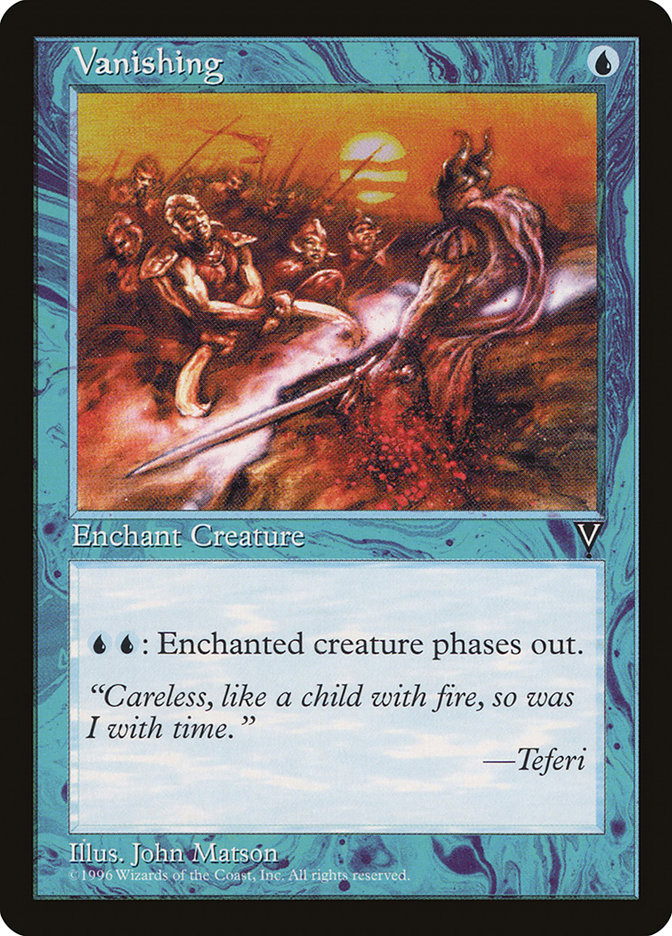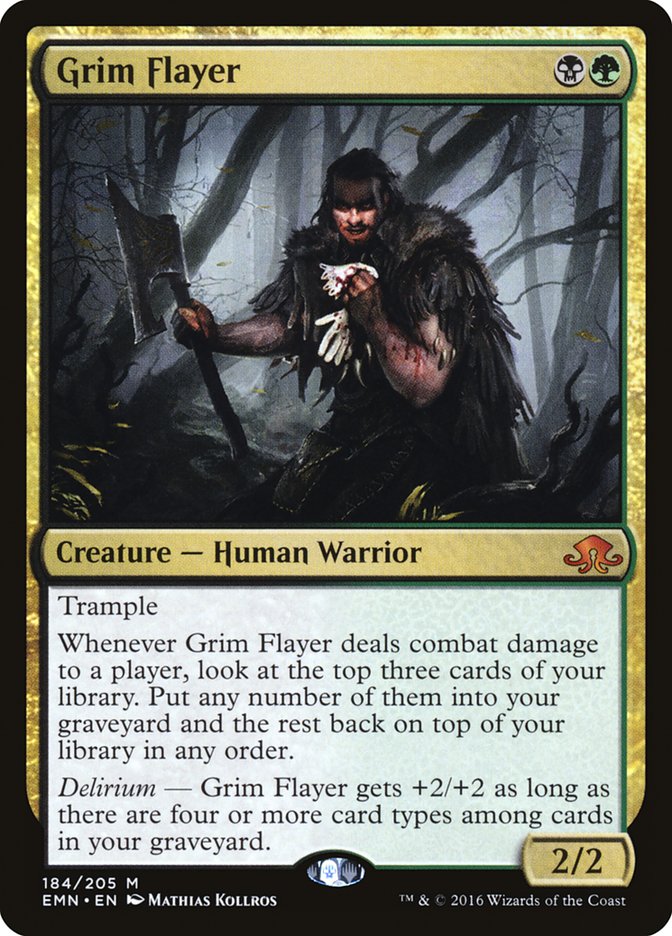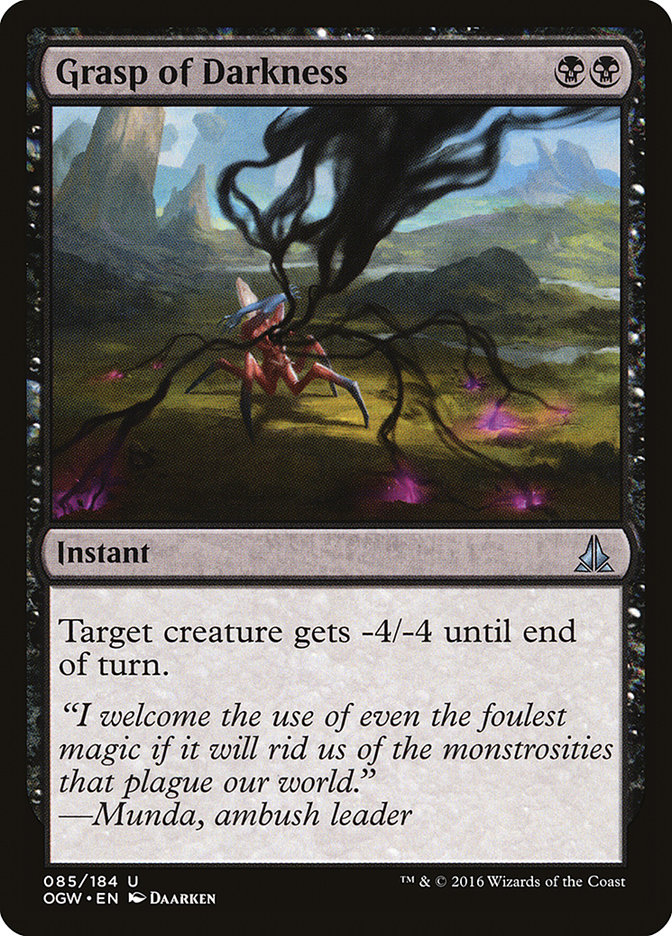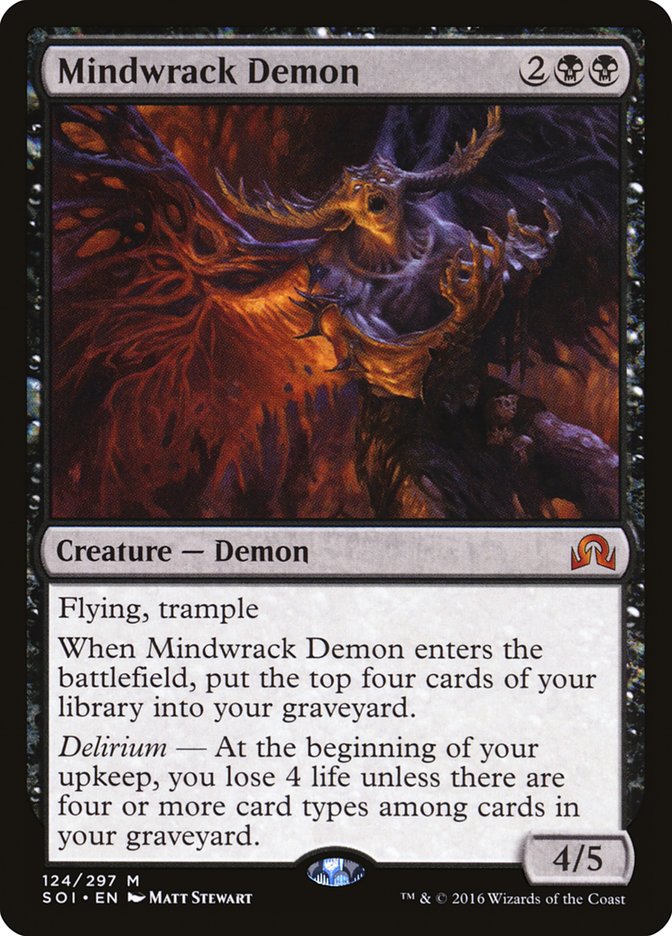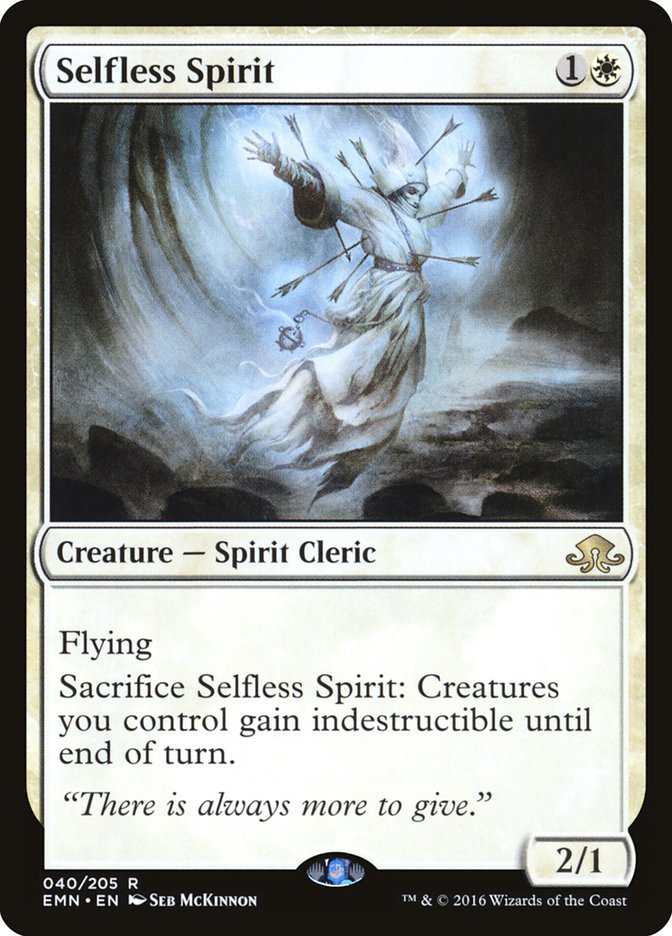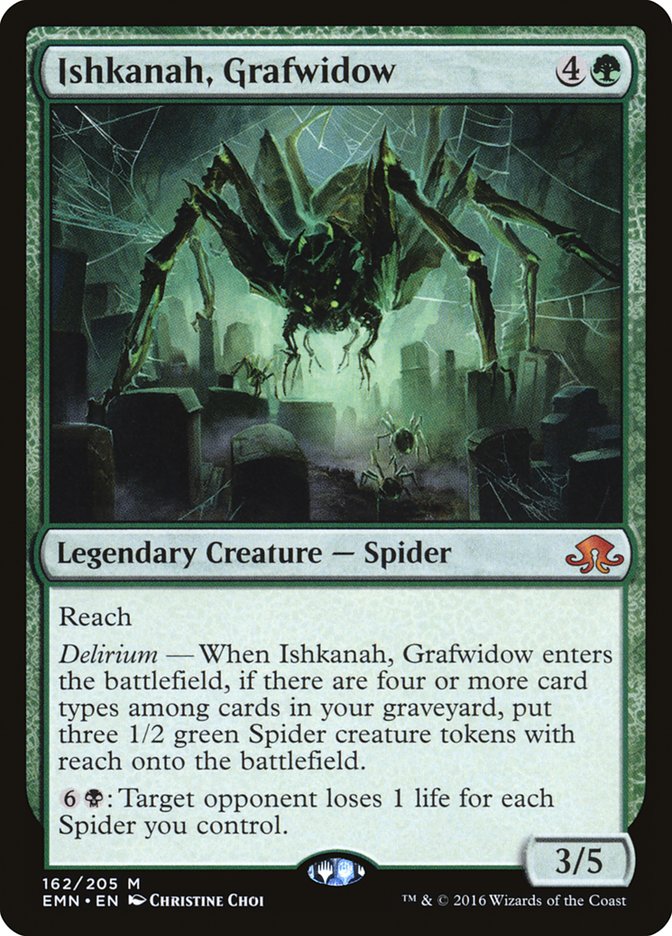I finally did it!
I got my first Top 8 on the SCG Tour!
Best of all, I did it while applying theory from one of my articles with a called-shot of sorts.
Creatures (19)
Planeswalkers (4)
Lands (25)
Spells (12)

To the surprise of literally no one, the tournament was dominated by a spattering of B/G Delirium and W/U Flash. Outside of the reasons outlined in the aforementioned article, part of my tendency to lean towards Flash over Delirium is derived from preferring to fight with a scalpel instead of a sledge hammer. That’s to say, I excel with decks that involve tight sequencing and threat assessment over some of the more midrange-y haymaker strategies.
Creatures (15)
- 2 Pilgrim's Eye
- 3 Mindwrack Demon
- 1 Tireless Tracker
- 1 Emrakul, the Promised End
- 3 Ishkanah, Grafwidow
- 4 Grim Flayer
- 1 Noxious Gearhulk
Planeswalkers (4)
Lands (23)
Spells (18)

One of the detractors from this line of thinking is that it is harder to go into a tournament in the blind with a deck that requires format-specific knowledge to succeed. Luckily, I have a fantastic team in Next Ridge Nexus (specifically, Aaron Sorrells) and a friend in Jadine Klomparens to assist in learning the tactics required to navigate the larger matchups in Kaladesh Standard.
Throughout the course of #SCGKNOX I played B/G Delirium seven times, and only lost two it twice. With one of those losses being against Brad Nelson (with the only game containing a significant amount of play coming down to topdecks on both sides), it’s hard not to feel confident about understanding the matchup. Going forward it will take a similar understanding of how the matchup tends to play out (and how to act as it progresses) for W/U Flash players to hope to compete against Ishkanah, Grafwidow and friends.
Phasing
One part of understanding the matchup is recognizing that different aspects of Delirium’s game plan are more important at different stages of the game. The three phases of the game can most easily be compartmentalized as the Developmental Stage, the Positioning Stage, and the Crowning Stage.
The three stages are most simply broken down into the early, mid, and late game of a match. The cards in Delirium tend to be relegated to specific sections of the game that they’re the most useful (or even castable), but W/U Flash has a pile of two- or three-mana cards with incredibly different effects.
That’s not to comment on the differences in difficulty to play each deck optimally–quite the opposite, in fact. To me, properly sequencing all of the spells in a Delirium deck sounds significantly harder than sequencing all of the spells in a Flash deck. That being said, the lower average power level of cards within W/U Flash tends to make it have a much lower floor if something is done wrong–that’s to say the Flash deck is significantly less forgiving than Delirium. Understanding the role of each card that you have at your disposal (as well as playing to the top of your deck) is a pertinent component of winning the tighter games you’ll play against Delirium.
Developmental Stage
The Developmental Stage is generally highlighted by two things-
1. The B/G Delirium player establishing Delirium.
2. The W/U Flash player assessing what kind of clock they can present and sculpting a game around it.
There are handfuls of subgames that are associated with each point, and understanding the roles each card from W/U Flash can cast goes a long way in properly balancing card advantage, positioning, and pressure.
The hardest games against B/G Delirium are the ones that involve a Grim Flayer on the play. Without the Thraben Inspector-into-Smuggler’s Copter draw, there isn’t a way to effectively block the Grim Flayer. If the Delirium player doesn’t have an early Vessel of Nascency or Grim Flayer, it can take a long time to ‘turn on’ Delirium the fair way.
If possible, prioritize getting Grim Flayer off of the battlefield during this stage. Preventing the Delirium player from turning on their most powerful cards (Ishkanah, Grafwidow; Traverse the Ulvenwald; Emrakul, the Promised End) is the best way to stay just ahead enough to pressure the opponent’s life total without sacrificing too many cards.
Smuggler’s Copter is the best thing that W/U Flash can do on the second turn of the game (save some corner-case scenarios in which it may be better to Declaration in Stone a Grim Flayer).
Recognizing that Delirium’s cards are more powerful than Flash’s cards means that the Flash player generally has to assume the role of the aggressor in the matchup. The longer the game goes, the more cards that are seen; the more cards that are seen, the more the slight differences in power can snowball in Delirium’s favor.
Smuggler’s Copter can efficiently attack past most of the creatures that Delirium presents as blockers, filters ill-positioned cards out of the Flash pilot’s hand, and is a creature that won’t die when Archangel Avacyn flips.
Some games aren’t as simple as “Play Smuggler’s Copter. Attack and loot a few times. Punk opponent out of the game.” The games that are longer generally have a significant amount of maneuverability.
If the game is going to be longer, it may be better to use a Spell Queller to block a Grim Flayer than casting a Reflector Mage to return the Grim Flayer to its owner’s hand. Reflector Mage can later be used to strand more important cards in the opponent’s hand, or even do a Shriekmaw impression against whatever crazy creature tokens the B/G Delirium deck may add to their side of the battlefield.
The Positioning Stage
This stage generally tends to happen as the opponent establishes Delirium and Flash has a plan of attack. Positioning is all about leveraging battlefield advantages into card advantage via Planeswalkers and developing a horde of creatures to punch through the opposing side’s blockers.
The biggest sources of card advantage (particularly in the pre-sideboarded games) are Liliana, the Last Hope and Gideon, Ally of Zendikar, and levying their impact on the board tends to dictate the entire pace of the game.
Liliana, the Last Hope puts the onus of attack on the Flash player. Liliana’s impending Endless Ranks of the Dead makes it so the Flash player can’t simply wait until they are comfortable attacking. If the Flash player doesn’t make a move, they will die as a result of their inaction. Between this and the Jace, Beleren sequencing impression (plus, plus, minus) that provides Liliana, the Last Hope’s controller with a near-endless stream of cards, a large number of games are decided by Liliana’s forcing the Flash player’s hand.
Gideon, Ally of Zendikar is tricky right now. After several hours of playtesting, Jadine and I came to the conclusion that it is normally correct to immediately -4 the first copy of Gideon that resolves.
Gideon, Ally of Zendikar has a long history of sticking around and being a never-ending token generator– and he’s very good at it. In this matchup, the sizing differences created by the Gideon Emblem end up making an enormous difference.
Archangel Avacyn no longer dies to Grasp of Darkness, and it makes the task of transforming the Angel a more realistic goal.
A Gideon Emblem enables approximately half the creatures in the deck to begin attacking into Ishkanah without it just being a chump attack on the creature’s part. Naturally, the opponent can double-block in order to profitably trade creatures in combat, but the opponent making a point to dedicate multiple blockers onto a single creature translates to the opponent having a harder time blocking every single attacking creature.
Mindwrack Demon and Ishkanah tend to stonewall an aggressive copy of Archangel Avacyn in a way that makes it so W/U Flash can’t profitably attack without using one of the precious few removal spells in the deck. With a pseudo-Glorious Anthem, it becomes realistic for Avacyn to attack into the Demon, and Avacyn isn’t attacking for almost no value into an Ishkanah.
Selfless Spirit normally pulls its weight against the Murder/Ruinous Path decks, but Liliana, the Last Hope having the ability to pick it off with her +1 ability is one of the more embarrassing bugs in the matchup.
It may sound silly to explain how strong a Glorious Anthem can be, but in this particular matchup, every creature being bumped up a single size turns a plethora of interactions in the deck on their head, tightening the noose before finishing the opponent off.
After the initial Gideon makes an emblem, subsequent copies of the Planeswalker are best used going as wide as possible with Knight Ally tokens or pressuring the opponent’s life total. It isn’t uncommon to have some of the more 0 into +1 into -4 sequences that he has been accustomed to using in his Standard tenure.
Generally speaking, Ishkanah, Grafwidow is the most important card that can hit the battlefield in The Positioning Stage. Everything that each player does is either an attempt to resolve a copy of Ishkanah or answer the opponent’s copy of Spider-mom. Revolutionary Rebuff was in my deck last weekend almost exclusively to counter opposing copies of Ishkanah for as little mana as possible.
One of the weirder plays I made over the weekend (that I stand by) is electing to attack Hoogland’s Liliana, the Last Hope with only Thraben Inspector after he casts Grasp of Darkness (and I counter it with Revolutionary Rebuff).
In this particular instance I felt it necessary to save Smuggler’s Copter from Grasp of Darkness, as my side of the battlefield would be devoid of pressure without it. Saving the Smuggler’s Copter, unfortunately, would make me cold to a Delirious Ishkanah, Grafwidow. It felt so important to deny Hoogland a set of 1/2 Spider tokens for a turn, that it felt better to deal three damage to Jeff, prevent him from turning on Delirium via Liliana’s second ability, and effectively sacrifice my Selfless Spirit to Liliana.
The copy of Stasis Snare in-hand makes it easy to answer a ‘naked’ copy of the Spider (or Mindwrack Demon, as the game played out) but without something better in hand, the Spider posse would have bought Hoogland too much time and he would have been able to utilize all of the cards in his hand while protecting his life total.
The deficit in positioning that Ishkanah creates for the Flash player can eventually be mitigated by either flipping an Archangel Avacyn or producing a slew of tokens via Gideon, Ally of Zendikar, but the jump in value that the Delirium player gains in a single turn from Ishkanah is enough to buy the Delirium player enough time to get their most powerful bombs online.
The Crowning Phase
The Crowning Phase may be a bit self-explanatory, but it is generally the phase in the game where a single player feels that they are ahead enough to begin applying significant amounts of pressure through the opponent’s battlefield. This doesn’t necessarily mean using Hissing Quagmire to pressure a Gideon, Ally of Zendikar or poking the opponent for a few points with Selfless Spirit. This is when players either tend to have a plethora of resources and someone has a way to break through a clogged battlefield.
From Delirium this tends to mean slamming a copy of Emrakul, the Promised End and ruining the Flash deck’s side of the battlefield; and for Flash this is most commonly achieved by flipping an Avacyn in order to destroy enough of the opponent’s blockers that they lack the resources to stay alive.
During The Crowning Phase it is the aggressor’s role to close out the game as quickly as possible (shut the door, so-to-speak), and it is the defender’s job to try and get the game back to The Positioning Phase of the game. Once the game returns to The Positioning Phase of play, it gives the defending player a chance to rebuild their side of the battlefield and a shot at being the aggressor in a future Crowning Phase.
The biggest bit of advice that I can give on The Crowning Phase from the Flash perspective is to try and sandbag an answer to Emrakul as the opponent approaches the proper mix of mana and card types in their graveyard to cast her. Stasis Snare is the easiest option, but there are also cases that involve using a Reflector Mage to get her out of the way. Even if there isn’t always a clear-cut answer to Emrakul, she isn’t impossible to play around, so being aware of how close the Delirium opponent may be to entering The Crowning Phase of the matchup is a big part of being able to pivot from the aggressor to the defender before successfully moving back to being the aggressor.
Sideboarding
While I’m normally opposed to sideboard guides, I received a heinous number of questions about sideboarding throughout the tournament and feel that the theory in my sideboard strategy against Delirium is worth noting. Last weekend I stuck to the following sideboard strategy against Delirium:
Out:

In:

There’s a common sideboarding joke among Magic players to the effect of “bad cards out; good cards in” that tends to do most of the explaining for the sideboarding.
This card is awful in this matchup. If I’m not mistaken, it was Todd Anderson that said it best when he described Spell Queller as doing little more than building a house of cards against a deck full of removal. Eventually they’re going to kill the Spell Queller, and when it happens, things have the ability to go much worse than when the original spell was cast. That Grasp of Darkness may have been about to kill a Smuggler’s Copter before, but now it’s killing an Archangel Avacyn.
Speaking of struggles, the point brought up before about how poorly Selfless Spirit matches up against Liliana, the Last Hope already puts Selfless Spirit in the hot seat, but the fact that it can’t attack into Spider tokens or save creatures from Grasp of Darkness really makes Selfless Spirit a liability in a matchup where Flash is already short on impactful cards.
A majority of the cards coming into the deck are good cards. Always Watching is a cheaper Glorious Anthem than Gideon, Ally of Zendikar; Spell Shrivel permanently deals with a copy of Ishkanah, Grafwidow; Jace, Unraveler of Secrets helps overcome the card quality deficit that Flash suffers from via burying the opponent in card advantage. Gisela, the Broken Blade is the lone exception to this, and is more-or-less a small power upgrade from Spell Queller. It may be reasonable to keep a single copy of Spell Queller over Gisela, but otherwise the rest of the sideboarding is sound.
Keep Playing
Despite being happy that I reached the Top 8 of the event, I’m confident that I could’ve won my Top 8 match with some more reps and time to prepare for the event. Nothing replaces actual games played, and no matchup primer or description of roles within a format is going to replace the knowledge that comes with actually making the in-game decisions that come with playtesting. I plan to spend most of the next two weeks tuning Flash as much as possible for #SCGINVI in Atlanta.
Reaching Top 8 felt wonderful, and it was refreshing to get the chip off my shoulder, but now I’ve had a taste of the elimination rounds, and I’ve gotta tell you…
I want more.


